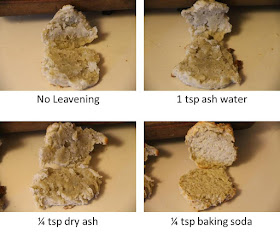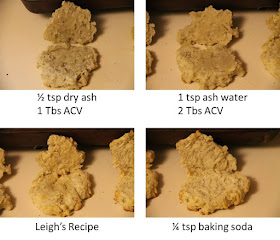As a recap, we calculated that the hydroxides in the ash water outnumber the carbonates nearly 3:1, and that one teaspoon of ash water should have the same leavening power as about 1/46 teaspoon of baking soda. Fortunately, baking with the ash water has turned out to quite a bit better than our prognostications suggested.
This is the recipe that we used as a starting point (and a positive control):
Base recipe:
0.5 cups all-purpose flour
0.125 (1/8) tsp salt
1 Tbs butter
1 tsp apple cider vinegar + milk to 0.25 cups
0.25 (1/4) tsp baking soda
Mix apple cider vinegar and milk to make a faux buttermilk. Combine flour, salt, butter, and baking soda in food processor and process until butter is cut in. Combine buttermilk and solid ingredients, mix well, and form into drop biscuits on a cookie sheet. Bake at 400 °F for 20 min. Yield: 3 biscuits. Serving size: 3 biscuits.
To modify it for wood ash-based leavening, we figured we'd need more acid to neutralize the hydroxides. Also, based on Leigh's experiments, using dry wood ash seemed to work just about as well as the ash water, so we did started with two variations on the base recipe:
Variation 1:
Same amounts of flour, salt, and butter
1 Tbs apple cider vinegar + milk to 0.25 cups
1 tsp ash water
no baking soda
Variation 2:
Same amounts of flour, salt, and butter
1 Tbs apple cider vinegar + milk to 0.25 cups
0.25 (1/4) tsp dry ashes
no baking soda
We also made a negative control, which was the same as the base recipe, but without the baking soda. This is what we got:
 |
| The 'no leavening' control was the least risen of the bunch, and the baking soda was much better than the rest. The ash water and dry ash were somewhere in the middle, but, like the calcium carbonate experiments we did here and here, closer to the 'no leavening' than the 'baking soda.' Still, they made a good lunch, and they're very tasty with cheese. |
 |
| Here you can see how the textures compare. No competition for the baking soda...yet. |
When we were taste testing these biscuits, we noticed that the biscuit with dry ash had a sort of tangy flavor, suggesting that all the apple cider vinegar hadn't been consumed. The ash water one didn't, but looking back at our recipe, we realized we actually meant to add 2 Tbs of apple cider vinegar to that one, which would have given us the 6x increase on the original recipe acid that we calculated in the last post. So, we decided to make another batch with two more variations:
Variation 3:
Same amounts of flour, salt, and butter
1 Tbs apple cider vinegar + milk to 0.25 cups
0.5 tsp dry ash
no baking soda
Variation 4:
Same amounts of flour, salt, and butter
2 Tbs apple cider vinegar + milk to 0.25 cups
1 tsp ash water
no baking soda
Also, as a reality check, we decided to make Leigh's recipe, which had twice the lipid, a lot more ash water, and actually less acid:
Leigh's Recipe:
0.5 cups all-purpose flour
0.125 tsp salt
2 Tbs butter
2 Tbs milk
2 Tbs ash water
0.5 tsp white vinegar
And since we had room on the cookie sheet for three more biscuits, we made another set of the base recipe with baking soda because, frankly, those are the only ones Katie has really liked so far.
Here are the results of the second round:
 |
| It shows in the texture, too. Both of the biscuits on the bottom earned Katie's seal of approval. |
Well, now we've got a conundrum! More ash water and less acid seems to be what it took to get the leavening effect we were going for. So, while we calculated that we would need to boost both the ash water content and the acid content in our recipe, the ash water content clearly makes a bigger difference. What gives?
The first thing that comes to mind is that the hydroxides in the ash water could have reacted with other ingredients in the recipe (i.e. the the butter or the milk), taking themselves out of the equation before the vinegar even had a chance to take a whack at them. So, it's possible that doubling down on the acid in the recipe wasn't really gaining us anything.
Similarly, sitting out on the kitchen counter, exposed to the air for a week, might have let the hydroxides react with carbon dioxide from the air, throwing our calculated hydroxide-to-carbonate ratio way off (and underestimating our total carbonate). We think that's a more likely possibility, because when we tried to titrate the ash water a second time several days later, it took a lot less acid to reach the end points.
 |
| We also helped increase the surface area of the ash water (i.e., it's opportunity to interact with atmospheric carbon dioxide) by storing it in a polycarbonate measuring cup one night. By the next morning, there was a crack in the cup and the ash water had run out onto the counter! Turns out, polycarbonate is not compatible with potassium hydroxide. Now we know! |
For what it's worth, we did calculate that if we were able to convert all the hydroxides into carbonates, 1 tsp of ash water would have the leavening power of about 1/22 tsp of baking soda. Since Leigh's recipe calls for 2 Tbs (6 tsp) of lye water, that's 6/22 tsp of baking soda. 6/24 tsp would be the same as 1/4 tsp, which is what our base case recipe called for. So, the theory sort of lines up with the experiment in this case.
The only other possibility we can think of is that we did something really wrong in our titration, and we're totally not ready to entertain that idea yet!
So, some final thoughts on ash water leavening: it works! Just follow Leigh's recipe instead of ours, and make the ash water well ahead of time so that it has time to pull carbon dioxide out of the air, eat through your polycarbonate measuring cups, and/or generally get to know you a little bit before you try to stick it in your biscuits.
Have you ever baked with ashes or ash water? How did it go?


Katie liked my biscuits? That made me so happy!
ReplyDeleteI tried quite a few different ingredient ratios and reported the ones that got the best results. Interesting to know about letting the ash water sit out to interact with CO2. I made a quart jar to simply keep on hand, and although it's lidded (not tightly) I'll have to see if it now makes a difference.
Great series Jake. It's a lot of fun to work on something as a team.
She did! And I agree--this was fun. I learned a lot from reading your posts and in the course of researching and writing this series.
DeleteI write a bimonthly recipe column that includes a history lesson in the particular ingredient or cooking method used in my recipes. I wanted to do one on chemical leavening and include one ash water leavened quick bread recipe. I don't see any specifics on your page or 5acresandaDream for how the ash water was made, as in the proportions of water to ash. I am also curious if you used just the white ashes or anything specific like that. I know it will differ from instance to instance, but I still want to know what you did in your situation. Thank you.
ReplyDeleteNevermind my previous comment, I just found it, not sure how I missed it.
ReplyDeleteMy mother was an artist with a wood stove and baking powder biscuits were made regular. She used the Magic Baking Powder recipe but she also made biscuits with hardwood ash. I'm not sure if a different amount was used but think it was about the same as baking powder.
ReplyDeleteHi, do you include your ash water recipe (how much ash to water)? Thx-
ReplyDelete